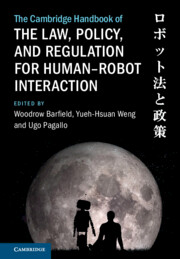
Satoshi Narihara
in Cambridge Handbook of the Law, Policy, and Regulation for Human-Robot Interaction (edited by Woodrow Barfield, Yueh-Hsuan Weng, Ugo Pagallo)
Cambridge University Press, December 2024
About the chapter: Today, robotics embodying artificial intelligence (AI) has rapidly developed and entered society. Human-robot interaction (HRI) has become an important issue in various social fields, such as healthcare and education. Human-robot interaction may promote personal autonomy among robots supporting individual decision-making and its implementation while conversely, HRI may threaten personal autonomy by controlling and manipulating the process of individual decision-making. In this chapter, I analyze differences in the concept of autonomy contrasting personal autonomy with machine autonomy, and then attempt to reconstruct how the two autonomies should be related by examining legal issues concerning privacy and freedom of expression when people use robots. As this chapter discusses, personal autonomy and machine autonomy differ considerably, even when using the same concept of autonomy. Given the state of HRI technology, it is appropriate to understand machine autonomy as having instrumental values as a means of serving personal autonomy. Furthermore, it is argued that the development of HRI will likely call for the implementation of a system of checks and balances among multiple robots to ensure autonomy as collective self-regulation for groups of robots connected through information communication networks, rather than ensuring the autonomy of individual robots.
About the book: This volume provides a unique perspective on an emerging area of scholarship and legislative concern: the law, policy, and regulation of human-robot interaction (HRI). The increasing intelligence and human-likeness of social robots points to a challenging future for determining appropriate laws, policies, and regulations related to the design and use of AI robots. Japan, China, South Korea, and the US, along with the European Union, Australia and other countries are beginning to determine how to regulate AI-enabled robots, which concerns not only the law, but also issues of public policy and dilemmas of applied ethics affected by our personal interactions with social robots. The volume’s interdisciplinary approach dissects both the specificities of multiple jurisdictions and the moral and legal challenges posed by human-like robots. As robots become more like us, so too will HRI raise issues triggered by human interactions with other people.
About the author: Satoshi Narihara was a HYI Visiting Scholar from 2023-24.
